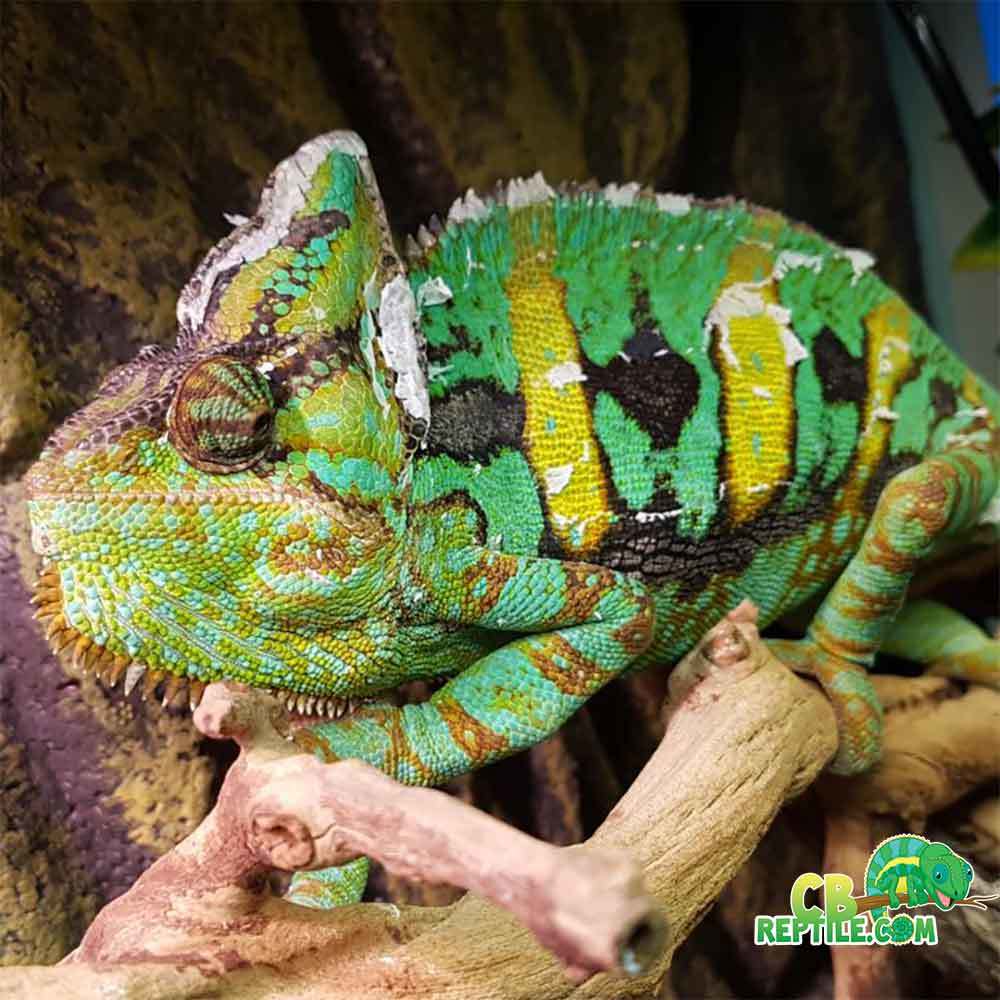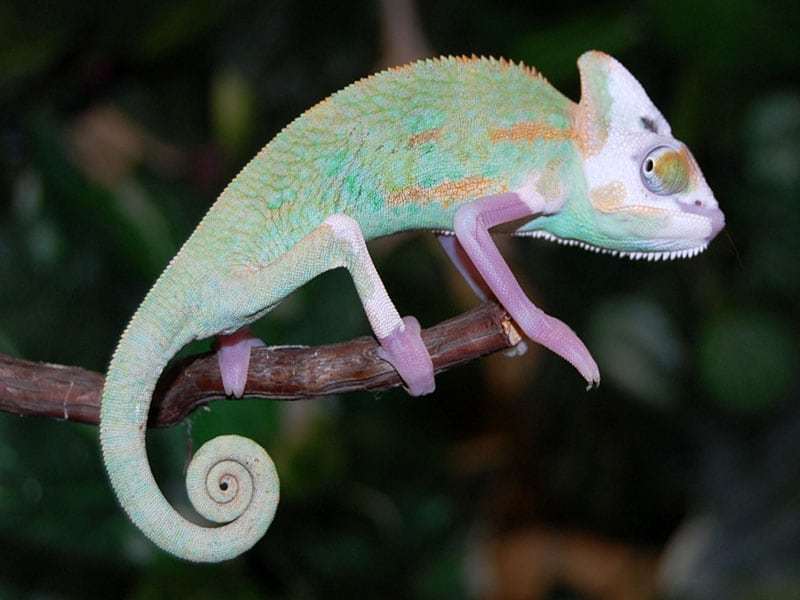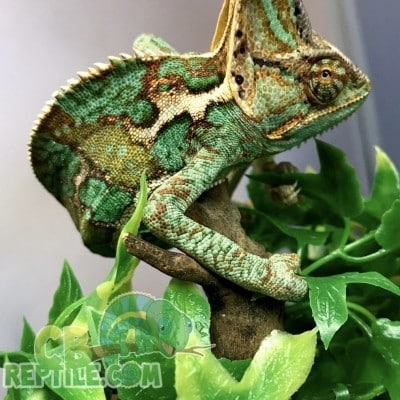Care Guide for Veiled Chameleons: Build the Habitat, Set the Climate, Raise Them Right

Habitat Construction: A Breezy Treehouse, Not a Glass Box

Veiled chameleons are arboreal masters. Think vertical space, airflow, and safe foliage. A habitat that breathes is the heart of their wellness:
- Enclosure Style: A screen or hybrid enclosure (solid sides on two panels, screen on others) helps balance humidity with ventilation. For a juvenile, 18″×18″×36″ works; for adults, aim for 24″×24″×48″ or larger. More height equals more microclimates and easier thermoregulation, ya know.
- Frame & Panels: Sturdy aluminum or PVC frame, fine mesh that won’t catch nails. If using a hybrid, position solid panels on the sides facing AC vents or drafts, and leave the front and top screened for breathability.
- Interior Layout: Create a vertical highway of safe branches (grapevine, sanitized natural limbs) and vines that meander from basking zones to shaded cover. Use zip ties or anchor points to keep perches secure. Offer multiple routes so your veiled can move without crossing wide open spaces.
- Live Plants: Pothos, schefflera, ficus, and hibiscus bring shade, humidity, and water-catching leaves. Rinse plants well, re-pot in organic soil (no perlite on the surface), and cover soil with river stones to discourage digging or accidental ingestion.
- Drainage: Misting adds water, and water needs an exit. Install a false bottom, drain tray, or bulkhead fitting to a catch bucket. Dry feet make for happy lungs, mon.
- Top Access: Keep the top clear for lighting—UVB and basking fixtures must sit safely above the screen with proper distance. That way your chameleon bathes in rays without any risky contact.
Design with intention: shaded pockets, leafy tunnels, and clear outposts for basking. When the space feels like a gentle hillside—light at the top, cool and leafy down below—you’ve nailed the vibe.
Lighting & UVB: Sunshine Science
UVB is the backbone of calcium metabolism. A linear T5 HO UVB fixture (e.g., 5.0 or 6%) mounted across the top provides an even wash. Mind the distance—typically 8–12 inches from the top perch through screen, but verify with manufacturer guidelines and, if possible, a UV index reader. Keep a photoperiod around 12 hours on, 12 off. Replace bulbs on schedule (usually 6–12 months, depending on brand and model), because the rays fade before the light looks dim to you, mon.
Temperature: Warm Sunshine Up Top, Chill Shade Below

Chameleons thrive when they can choose their own comfort zone. Provide a gentle gradient:
- Basking Spot: ~88–92 °F (31–33 °C) at the top perch. Use a dome fixture with a standard basking bulb (no colored lights) and adjust wattage or distance to hit the target.
- Ambient Daytime: 72–82 °F (22–28 °C) through the mid-levels with cooler pockets lower down.
- Night: A drop to 65–72 °F (18–22 °C) is fine for most homes. Avoid bright lights at night; veileds appreciate real darkness.
- Monitoring: Put one digital probe at the basking branch and one mid-level. Data-loggers are a sweet upgrade—set it and check the curve later with a smile.
Heat should come from above to mimic the sun. Never bake the whole enclosure—give options, mon. If your pet looks washed out or gapes under the bulb, the top is too hot; raise or dim the lamp.
Humidity & the Need for a Misting System: Rain on the Leaves, Not in the Lungs
Veiled chameleons don’t drink from bowls—droplets on leaves are their favorite fountain. Humidity should cycle like a tropical morning and afternoon storm with dry-out between, to keep air fresh and prevent respiratory issues.
- Humidity Targets: Baseline 40–60% with spikes into 70%+ during misting windows. Allow a gentle dry period afterward.
- Automated Misting: A programmable misting system keeps schedules consistent, mon. Two to three sessions daily (e.g., early morning and late afternoon/evening) provide drink opportunities and surface moisture without you babysitting the pump.
- Session Length: Short cycle (30–60 seconds) for wake-up dew, a longer mid/late cycle (2–5 minutes) to fully bead leaves, and an optional quick rinse later if your ambient air is dry.
- Drippers: A slow dripper on broad leaves can help shy drinkers. Collect runoff with that drainage you built earlier.
- Ventilation Balance: Screen panels let excess humidity vent, while plant clusters and timed misting maintain hydration. Fresh air plus clean water equals smooth breathing.
Remember to let the enclosure dry between showers. Constant dampness invites trouble; rhythmic moisture brings health, mon.
Diet & Supplements: Fuel the Color, Build the Bones

Feed a varied rotation of appropriate-size crickets, roaches, silkworms, hornworms, and occasional treats like black soldier fly larvae. Gutload your feeders with leafy greens and quality commercial formulas. Dust lightly with plain calcium most feedings, and use calcium with D3 plus a multivitamin on a conservative schedule based on your UVB intensity and veterinary guidance. Fresh, diverse nutrition keeps casque and limbs strong, eyes bright, and that island swagger alive.
Hatchling Care: Small Perches, Gentle Showers, Plenty of Browsing
When babies arrive, scale the environment to their tiny toes. Hatchlings need safe microclimates and easy access to water and food:
- Nursery Enclosure: Start small—screen or hybrid setups with dense plant cover, fine branches, and short distances between basking and shade. Keep feeders close to where babies roam.
- UVB & Heat: Same principles, softer delivery. Provide a mild basking spot around 82–85 °F (28–29 °C) and good UVB access with shaded retreats.
- Misting: Frequent, lighter cycles to bead leaves without drenching. Babies drink early; you’ll see them lick droplets. Allow dry-out to maintain clean air.
- Feeding: Offer fruit flies (Drosophila melanogaster then hydei), pinhead to 1/8″ crickets, and small roaches. Feed 1–2 times daily in amounts they actively hunt, removing leftovers.
- Supplements: Light, frequent calcium; D3 and multivitamin sparingly per vet guidance and UVB strength. Over-supplementing can be as problematic as under-doing it, mon.
- Observation: Watch posture, appetite, and sheds. Strong grip, bright eyes, and steady weight tell you the nursery groove is right.
Hatchlings are solitary spirits like the adults. If you start in small groups to keep feeders nearby, monitor closely for competition. At the first sign of stress or nipping—separate to individual digs.
Daily Rhythm & Cleanliness
Veileds feel best when the keeper’s routine is smooth. Lights on and off at consistent times; misters on a schedule; spot cleaning daily; deeper cleaning as needed with reptile-safe products. Check temps morning and evening. Trim plants, wipe the glass panels if you use a hybrid, and empty the drain bucket before it overflows—no indoor monsoon, please!
Why Work with Experience
Good husbandry is part art, part science, and all patience. That’s where experienced breeders shine. For almost twenty years, CB Reptile has been a trusted name among chameleon keepers—well-started animals, helpful support, and husbandry that respects the animal’s nature. If you’re browsing for a healthy chameleon for sale, put your energy with folks who offer transparency, lineage info, and proper care from day one.
